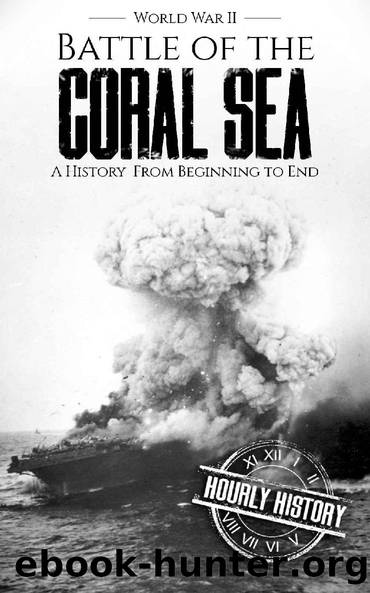Battle of the Coral Sea - World War II: A History from Beginning to End (World War 2 Battles Book 10) by Hourly History

Author:Hourly History [History, Hourly]
Language: eng
Format: epub
Publisher: Hourly History
Published: 2019-05-06T00:00:00+00:00
Chapter Four
The Calm Before the Storm
âAfter a battle is over, people talk a lot about how decisions were methodically reached, but actually thereâs always a hell of a lot of groping around.â
âAdmiral Frank Jack Fletcher
Admiral Fletcher, knowing that the Japanese would realize that at least one American carrier was in the area, headed south during the night in order to rejoin Task Force 11 at dawn on May 5, 400 miles south of Tulagi. Although radar on the Yorktown detected the presence of an unidentified aircraft, visibility was too low for the American fighters to make visual contact with the Japanese.
Fletcher, who had taken command of Task Force 17 on January 1, 1942, was a surface fleet admiral who was chosen to lead the carrier task force over senior officers. For aviators, this choice was a mistake, and Fletcher would have to prove his abilities. His training had taken place on the job as he escorted troops to the South Pacific, and he had received his training from experts like Vice Admiral William âBullâ Halsey, Vice Admiral Wilson Brown, and Rear Admiral Aubrey Fitch, who was an aviation expert.
When the Task Forces joined at 8:15 am on May 5, Fletcher reorganized his fleet. Admiral Aubrey Fitch was given command of Task Group 17.5, with the two carriers Lexington and Yorktown, and Admiral Thomas Kinkaid had command of Task Group 17.2, an attack group of five cruisers and five destroyers. The remainder of Fletcherâs fleet, which was given the name Task Group 17.3, was a combination of American and Australian cruisers and destroyers, with Australian Rear Admiral John G. Crace in command. Task Group 17.3, which consisted of the heavy cruiser Chicago, the destroyer Perkins, and the Australian cruisers Australia and Hobart, would later come to be known as Task Force 44.
Support was also provided by PBY Catalinas and by USAAF and RAAF heavy and medium bombers and reconnaissance aircraft that were based in Australia.
As the Task Forces were meeting up, four F4F Wildcat fighters from Yorktown shot down a Kawanishi Type 97 aircraft which was part of the Yokohama Air Group. Learning from a message sent from Pearl Harbor that the Japanese were planning to land on Port Moresby on May 10, Fletcher decided that he would take his fleet north toward the Louisiades. As Fletcher was sailing northwest toward the likely route that the Japanese Port Moresby Invasion Force would take, Admiral Takagiâs Striking Force entered the Coral Sea. Both Fletcher and Takagi were unaware of the otherâs position or the size of the enemy fleet.
By midday on May 5, the Japanese Striking Force, which had been swiftly moving down the Solomons on the eastern flank, was east of San Cristobal Island with the idea of covering what they expected to be the line of retreat for the U.S. carriers.
May 6 saw little action, partly due to the bad weather, which prevented the Americans and Japanese from locating one another, although the 25th Air Flotilla, based at Rabaul, was flying Japanese reconnaissance.
Download
This site does not store any files on its server. We only index and link to content provided by other sites. Please contact the content providers to delete copyright contents if any and email us, we'll remove relevant links or contents immediately.
| Africa | Americas |
| Arctic & Antarctica | Asia |
| Australia & Oceania | Europe |
| Middle East | Russia |
| United States | World |
| Ancient Civilizations | Military |
| Historical Study & Educational Resources |
The Light of Days by Judy Batalion(1063)
First Platoon: A Story of Modern War in the Age of Identity Dominance by Annie Jacobsen(902)
Stalin's War: A New History of World War II by Sean McMeekin(861)
The Pacific War 1941-1943 by James Holland(803)
Walk in My Combat Boots by James Patterson(764)
The American War in Afghanistan by Carter Malkasian(741)
Victory's Price (Star Wars) by Alexander Freed(734)
The Vietnam War: An Intimate History by Geoffrey C. Ward & Ken Burns(721)
Blood and Ruins: The Great Imperial War, 1931-1945 by Richard Overy(686)
Operation Pedestal by Max Hastings(683)
Concepts of Space by Jammer Max;(667)
Cold War (Alexander King Book 2) by Bradley Wright(660)
Extreme Fitness by Chris McNab(654)
The Madman Theory by Jim Sciutto(651)
Flying Tiger by Samson Jack(633)
World War II Infantry Fire Support Tactics by Gordon L. Rottman(612)
Pathfinders by AL-KHALILI JIM(611)
Panzerkrieg by Mike Syron(599)
Bismarck by Jean-Paul Bled(585)
